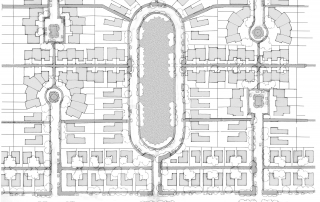Reconsidering the Cul-de-sac
Michael Southworth and
Eran Ben-Joseph
For over five decades developers, homebuyers, and traffic engineers have favored the cul-de-sac, a basic building block of the American suburb. Despite its popular success, the “loops and lollipops” street pattern has been repeatedly criticized by many leading architects and planners, particularly New Urbanists, who strongly advocate the inter- connected gridiron pattern. The cul-de-sac has come to symbolize all the problems of suburbia— an isolated, insular enclave, set in a formless sprawl of similar enclaves, separated socially and physically from the larger world, and dependent upon the automobile for its survival. Nevertheless, much can be said in favor of the cul-de-sac street as a pattern for neighborhood space.

